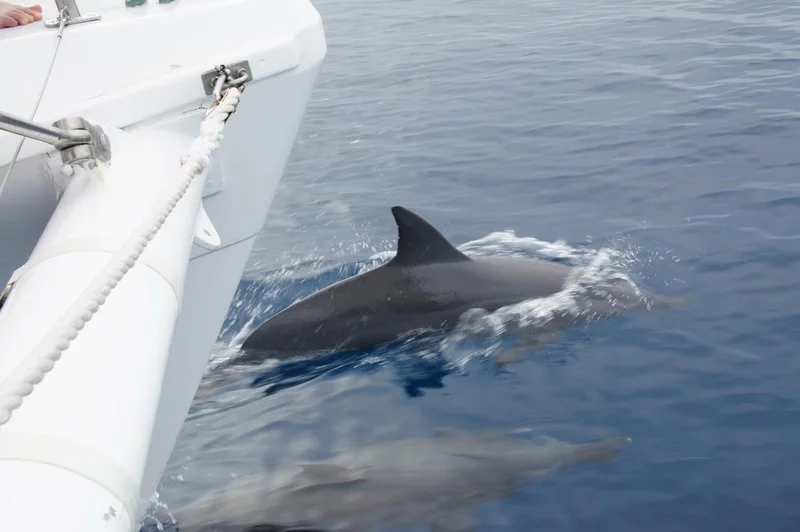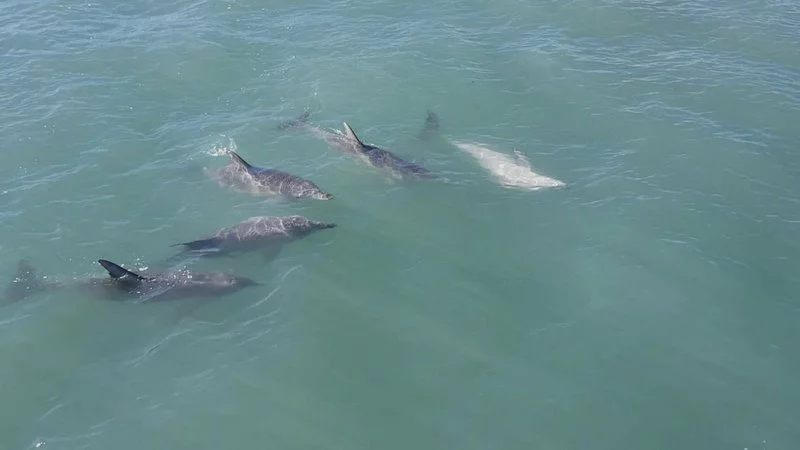Dolphins are up there as some of the most popular and most loved marine animals. They are a marine mammal in the cetacean group which includes whales, dolphins and porpoises. Just like other cetaceans dolphins are extremely intelligent animals that have been observed showing self awareness, problems solving skills and even complex emotions like grief and joy. Dolphins can be found world wide, not only in the ocean but also in freshwater with a few species of dolphin calling rivers around the world home.
Here in the Whitsundays the two most common dolphins that you will encounter are the bottlenose dolphins and the Australian humpback dolphin.
The bottlenose dolphin group is probably the most widely known group and is made up of three different species. In the Whitsundays you can spot two types of them, the common bottlenose and the Indo-Pacific bottlenose. The Indo-Pacific bottlenose dolphin is the smaller of the two growing to 2.6 meters on average and weighing in at almost 300 kilograms. While the common bottlenose can reach up to 4 meters in length and sometimes weigh up to 650 kilograms. Apart from their size there are other slight differences in their appearance. The common bottlenose has colouring that can range from light grey to almost black near their dorsal fin and light grey to white on their belly. They also have a rounded snout or rostrum and tall curved dorsal fins. The Indo-Pacific bottlenose is light to dark grey on its back fading to white on its belly, it is also quite common for the belly to have spots. This smaller species also has more teeth and a longer more slender snout.
The rounded snout of both of these species is where the name “bottlenose” came from.
Both of these species on average live for 30-40 years and are highly social animals sometimes being part of groups of over 100 and sometimes 1000 individuals or more, however it is more common to see them in smaller groups. These guys are also extremely playful and will often come and “surf” the bow waves of boats as they cruise around the Whitsundays.

Common bottlenose dolphins have quite a wide distribution and can be found in temperate and tropical waters worldwide whereas the Indo-Pacific bottlenose has a smaller range which is limited to coastal and inshore waters from the southern tip of Africa to the Solomon Islands in the east. The area that they inhabit determines the diet of the dolphins. Nearshore populations will target benthic (bottom) fish species while other populations, especially offshore, will target schooling fish species like mullet and mackerel. Bottlenose dolphins are also extremely creative and some populations have even developed the ability to use tools like sponges to protect their snout while the forage in the sand for food.
As with all whale and dolphin species, bottlenose dolphins are under-threat from humans and our activities. Pollution, overfishing, accidental entanglement and being caught as bycatch all lead to death and population declines in the dolphins. Noise pollution is another significant threat to them. Bottlenose dolphins like all dolphin species use echolocation, also known as sonar, to enable them to build a detailed image of their underwater environment, essentially seeing with sound. They use this ability to hunt, communicate and navigate. Underwater noise pollution from human activities like underwater drilling and military tests impacts the dolphins ability to echolocate which can lead to events like mass strandings.

The Australian humpback dolphin is a lesser known species and one of four species in the humpback dolphin family. These dolphins get their name from their elongated, low dorsal fin and humped back. Their appearance also differs from other dolphin species in that they also have much larger foreheads which have a melon shaped swelled appearance. This species also has grey colouring that can range from light to dark grey depending on the individual. Adults of this species can grow to 2.7 meters and weigh 260 kilograms. Their life span is similar to that of the bottlenose dolphins with individuals living for around 30 years. They are also very social animals and can be seen swimming in groups of up to 60 individuals, although it is more common to see them in small groups of 2-6 individuals.
The Australian humpback dolphin has a much smaller distribution than the bottlenose species, only being found in the waters of Australia and Papua New Guinea. They are also not known to be overly migratory, preferring to stay in shallow coastal and estuarine habitats in tropical and subtropical regions. In their small sheltered territories these dolphins love to feed on a variety of fish, crustaceans and molluscs such as squid and octopus.
Living close to the coast and river/estuarine areas means these dolphins are susceptible to human threats. These include pollution, fishing nets, habitat destruction and depletion of their food sources and also noise pollution which like with all dolphins can have a significant impact on their echolocation abilities. Compared to other species of dolphin the population of the Australian humpback dolphin is quite small and the IUCN has listed this species as vulnerable to extinction.



